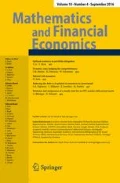Abstract
A longstanding unresolved question is whether the one-period Kyle model of an informed trader and a noisily informed market maker has an equilibrium that is different from the closed-form solution derived by Kyle (Econometrica 53:1315–1335, 1985). This note advances what is known about this open problem.
Similar content being viewed by others
Notes
Although it is linguistically natural and convenient to treat the market maker as a single individual, one should really imagine a continuum of market makers competing with each other for order flow.
We should emphasize that the problem of uniqueness of equilibrium in the dynamic versions of the Kyle model is different in an essential way from the question of uniqueness in the one-period model. [1] shows that in the continuous time setting the derived equilibrium is unique within a nice class of functions. In the dynamic setting the uniqueness of the Kyle equilibrium was studied by [12] for the class of tame equilibria, where theoretical results and computational experiments suggest the presence of multiple equilibria!
We feel that we should clearly state our understanding of the relationship between our work and BKL. The statement of our Theorem 2.1 improves the statement of their Corollary 1 by replacing an unspecified positive constant a with 1. The proof in BKL actually proves the result with \(a = 1\), but under BKL’s maintained assumption of “admissibility,” which requires that the variance of the informed trader’s order is finite. Our proof is much simpler and more direct, and does not require this assumption. Our Theorem 2.2 has the same statement as the first part of BKL’s Result 2, but again their result has the maintained assumption of admissibility, and our proof is simpler and more direct. BKL has no analogue of Proposition 3.3, which implies Theorem 1.2. Our Lemma 4.1 is Corollary 2 of BKL, and the respective proofs are similar. BKL has no analogues of our Corollary 4.2 and Propositions 4.3 and 4.4. The assertions of the first two of these would follow immediately, at least under the assumption of admissibility, if the overall argument of BKL was correct, but it has not yet been accepted by the profession, and it remains to be seen whether it can be brought to a satisfactory condition.
References
Back, K.: Insider trading in continuous time. Rev. Financ. Stud. 5, 387–409 (1992)
Back, K., Baruch, S.: The Kyle model. In: Encyclopedia of Quantitative Finance. Wiley, Hoboken (2010)
Boulatov, A., Kyle, A., Livdan, D.: Uniqueness of equilibrium in the single period Kyle’85 model, working paper (2005)
Boulatov, A., Kyle, A., Livdan, D.: Uniqueness of equilibrium in the single period Kyle’85 model, higher Economic School working paper (2013)
Eremenko, A.: Singularities of inverse functions. www.math.purdue.edu/~eremenko/dvi/sing1.ps (2013)
Hellwig, M.: On the aggregation of information in competitive markets. J. Econ. Theory 22, 477–498 (1980)
Krantz, S.G.: Handbook of Complex Variables. Birkhäuser, Basel (1999)
Krutchkoff, R.G.: Classical and inverse regression methods in calibration. Technometrics 9, 9425–9439 (1967)
Kyle, A.S.: Continuous auctions and insider trading. Econometrica 53, 1315–1335 (1985)
Li, K.C.: Sliced inverse regression for dimension reduction. J. Am. Stat. Assoc. 86, 316–327 (1991)
Simon, B.: Basic Complex Analysis: A Comprehensive Course in Analysis, Part 2A. American Mathematical Society, Providence, RI (2015)
Takayama, S.: Price manipulation, dynamic informed trading, and tame equilibria: Theory and computation, discussion Paper No. 492, University of Queensland (2013)
Acknowledgments
We are greatly indebted to Alexandre Eremenko for discussions. We are grateful for his patience in answering our many questions. We are also indebted to him for an improvement of our main result. Monteiro acknowledge the financial support of CNPq-Brazil.
Author information
Authors and Affiliations
Corresponding author
Rights and permissions
About this article
Cite this article
McLennan, A., Monteiro, P.K. & Tourky, R. On uniqueness of equilibrium in the Kyle model. Math Finan Econ 11, 161–172 (2017). https://doi.org/10.1007/s11579-016-0175-7
Received:
Accepted:
Published:
Issue Date:
DOI: https://doi.org/10.1007/s11579-016-0175-7



